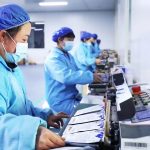In recent years, with the development of industry 4.0, the manufacturing industry in China is developing rapidly from “manufacturing” to “intelligent manufacturing”. 3D printing technology has been widely used in China’s manufacturing industry. 3D printers can provide efficient and low-cost support for die design and manufacturing. Even with the rapid development of 3D printing technology, in some areas, it has gradually begun to subvert the die technology, forming a direct competitive relationship with it.
“Compared with 3D printing technology, traditional mould manufacturing needs more steps and processes, and the mould production cycle is longer. When a mould manufacturer launches a new product, the new product must pass strict international standards and certification before it goes on the market, and the certification of many parts will take a lot of time. This will put new products at a very disadvantageous position in terms of time to seize the market. And 3D printing injection mould is an efficient solution. Well-known manufacturers do this by using 3D printing technology to make injection moulds in their open laboratories. According to the Secretary-General of the International Association of Modeling, Luo Baihui, it usually takes several weeks to two months to produce a mould. Using 3D printing technology, the prototype of the die can be completed in a few hours, and can be modified immediately according to the test results. Then the final product sample is injected. Samples of these products can be sent directly for certification, while traditional ,ould manufacturing may still be in production. Even before the final confirmation of the mould, 3D printing products have been certified, greatly shortening the development cycle. Only in the die production cycle, 3D printing technology has had a certain impact on the traditional die manufacturing.
However, industry experts say that although 3D printing technology has many advantages, such as short production cycle, convenient raw materials, uniform product pressure and so on, 3D printing technology can not completely replace the traditional mould manufacturing methods, because there are still some problems in the production process of 3D printing technology. For example, 3D printing technology is to process products layer by layer, which will shorten the production cycle of the mould, but also lead to stepped effect on the surface of the mould. Similar problems exist in direct printing moulds, which require mechanical processing or sandblasting to eliminate these tiny, toothed edges in the later stage. In addition, holes less than 1 mm must be drilled, larger holes need reaming or drilling, thread characteristics need tapping or milling, these secondary processing greatly weakens the speed advantage of 3D printing.
At the same time, in order to ensure good material fluidity, injection moulds need to be heated to very high temperature. Aluminum and steel moulds usually undergo 500 F (260 C) or even higher temperature environments, especially in the processing of high temperature plastics such as PEEK and PEI materials. It is easy to produce thousands of parts with metal dies, which can also be used as transitional moulds before the final production of moulds comes out. Mould materials manufactured by 3D printing technology are usually photosensitive or thermosetting resins, which are cured by ultraviolet light or laser. Although these plastic moulds are relatively hard, they are destroyed very quickly under the thermal cycling conditions of injection moulding. In fact, in mild environments, 3D printing moulds usually fail within 100 times, such as high-temperature plastics such as polyethylene and styrene. For glass filled polycarbonate and high temperature resistant plastics, only a few parts can be produced.
In addition, one of the main reasons for using 3D printing is its low cost. The cost of production-grade machined moulds is generally $20,000 or more, which means that they are comparable to the $1,000 printing dies. However, this analogy is not fair. The evaluation of printed die editions usually only considers material consumption, but does not consider manual, assembly and installation, injection system and hardware. ProtoLabsd’s aluminium mould, for example, costs $1,500 to produce. If more parts need to be produced, using 3D printing mould, every 50-100 products need to be reprinted, assembly machine testing new mould. On the other hand, regardless of the plastics used, the aluminium die is usually in good service after the production of 10,000 parts. Therefore, in terms of production costs, 3D printing is not more cost-effective than traditional die manufacturing methods.
In addition, in product design, the principle and practice of traditional injection mould manufacturing has a history of more than a century. The industry has studied it thoroughly, such as drawing angle must be greater than or equal to 5 degrees to meet the requirements of most aluminum molds. Injection-moulded plastic parts for 3D printing moulds face challenges, and extra care is needed for the number and location of ejector pins for plastic moulds. In terms of increasing cavity wall thickness and reducing pressure, 3D printing moulds (especially high injection temperature) are more flexible to some extent. The design of gate is also different. Tunnel gate and point gate should be avoided. Direct gate, sector gate and wing gate should be increased to three times the normal size. The flow direction of the polymer in the printing mould should be consistent with the 3D printing line to avoid high filling caused by viscosity and low pressure. The cooling system can improve the life of the mould to a certain extent, but it will not significantly reduce the number of cycles of the printing mould, because the heat dissipation capacity of the 3D printing is not as good as that of the aluminum or steel.
In summary, 3D printing technology will not completely replace the status of traditional mould and mould manufacturing industry. Compared with traditional mould manufacturing, 3D printing mould still has some shortcomings in product quality, product cost and mould design. Moreover, 3D printing is not suitable for mass production. The unit cost of producing 1 piece and 10,000 pieces is almost the same, and when 3D printing is needed.
About PTJMould Industrial Company Limited
PTJmould is a China mold maker of plastic molds- injection mold, die casting moulds, plastic blow molding, rotational molding, medical plastic injection molding, two shot plastic injection molding, insert molding, overmolding, metal injection molding, micro injection molding, powder injection molding, ceramic injection molding, liquid injection molding, husky injection molding, household mold, casting mold, die mold tool, custom molds, china moulds, rapid prototyping tooling, plastic prototyping tooling, punch press tooling, die and tooling for mobile/ cell phone parts, automotive parts, vacuum cleaners, rechargeable tools, telephones, copiers, computers, multimedia speakers, and many other electronic products and household appliances. And also a plastic product manufacturer, mold manufacturer China– plastic parts, plastic water tank, plastic balls, plastic containers, plastic buckle, plastic anchor, plastic hanger, plastic spoon, plastic pipe fitting, plastic tumble, plastic tableware, plastic cups, plastic bottles, plastic tray, plastic cosmetic container, plastic case, plastic food container, plastic chairs, plastic caps, plastic cap closure, plastic tubes, plastic water pipes, plastic knobs, plastic tubing, plastic utility boxes, plastic racks and so on.
Link to this article:Does 3D Printing Replace Traditional Mould Manufacturing?
Reprint Statement: If there are no special instructions, all articles on this site are original. Please indicate the source for reprinting:Mold Wiki,Thanks!^^


